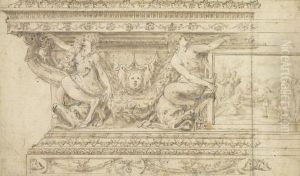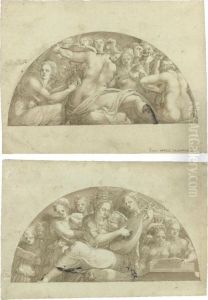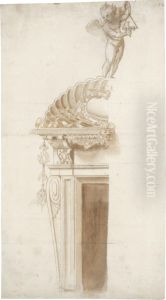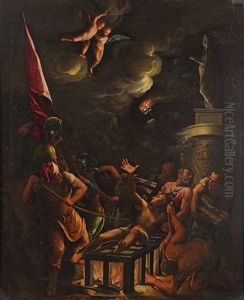Ippolito Andreasi Paintings
Ippolito Andreasi was an Italian painter who played a significant role in the late Renaissance period, primarily working in Mantua, Italy. Born in 1548 in Mantua, he became an important figure in the development of Mannerist art, a style that emerged in the later years of the Italian Renaissance. This style was characterized by its artificial (as opposed to naturalistic) qualities, including elongated proportions, highly stylized poses, and a lack of clear perspective. Andreasi's work is often noted for its dynamic compositions and vibrant colors, which were typical of the Mannerist aesthetic.
Andreasi was closely associated with the workshop of Giulio Romano, a leading artist of the time, and his works reflect the influence of Romano's dynamic compositions and innovative use of space and perspective. Through this association, Andreasi was involved in several significant projects, including the decoration of the Palazzo del Te in Mantua, one of the most famous examples of Mannerist architecture and interior design. His contributions to the Palazzo del Te and other projects in Mantua demonstrate his skills in fresco painting, a medium that was pivotal in the Italian Renaissance and Mannerist periods.
Despite the prominence of his work in Mantua, specific details about Andreasi's life and career are somewhat scarce, and his reputation has been somewhat overshadowed by more famous contemporaries such as Tintoretto, Veronese, and Romano himself. However, his contributions to the Mannerist movement and the artistic landscape of Mantua during the late 16th and early 17th centuries remain significant. Andreasi's work is an important link in the chain of artistic development in Italy, bridging the gap between the High Renaissance and the emergence of the Baroque style.
Ippolito Andreasi passed away in 1608 in Mantua. Though not as widely recognized as some of his peers, his artistic legacy is preserved in the frescoes and paintings that adorn the walls of Mantuan buildings, serving as a testament to his skill and creativity. Through his work, Andreasi has left an indelible mark on the history of Italian art, embodying the transitional period of Mannerism with his distinctive style and compositions.





